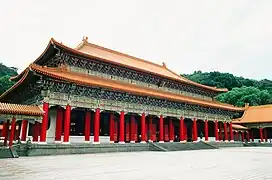Ci shrine
A Ci shrine, (祠), is a semi-religious facility that originated in China and was widely used in the East Asian cultural sphere for traditional folk beliefs, mainly for the worship, sacrifice, deity, ancestor, or sage or martyr, in the form of a temple-style building.[1]

| Ci shrine | |||||||
|---|---|---|---|---|---|---|---|
| Chinese name | |||||||
| Chinese | 祠 | ||||||
| |||||||
| Korean name | |||||||
| Hangul | 사 | ||||||
| Hanja | sa | ||||||
| Japanese name | |||||||
| Kana | じ/し/ほこら | ||||||
| |||||||

They are a kind of Chinese temple architecture and contrast with Miao Shrines which enshrine deities instead of ancestors.[2]
They are sometimes called Cimiao (祠廟) which is a combination of the name of it, and the Miao shrine.[3]
Ancestral shrines were often built by the public for the common worship and dedication of widely revered figures, and in some cases living figures were also dedicated. For example, in Ming dynasty, the people of Teng County built a shrine to the life of Zhao Bangqing, who was a clean official in the area and was about to leave for his post in the capital, and "yellow children, white men and old men, worshiped him". Hero shrines were built to honor the spirit of loyalty and righteousness and to memorialize the martyrs who died for the country.[4] The memorial shrine in Taiwan was built by the Republic of China government after World War II. In addition, there is also the Hero cult, which is dedicated to heroes.[5]
Since ci and miao are similar in nature, some ci established to commemorate sages are also considered by the faithful to be used for praying for good fortune and avoiding evil, and the objects worshipped are also regarded as deities, so they are sometimes mixed. Some places dedicated to Confucianism, Daoism, Buddhism, or gods and saints of folk beliefs are also named as ci, such as Wong Tai Sin Temple.[6]
The Ancestral shrine dedicated to ancestors contains this character.[7]
Ancestral shrines in the Korean Peninsula were introduced from China during the Three Kingdoms, and gradually became popular during the Goryeo Dynasty and flourished during the Joseon Dynasty, but are now less common.
Ancestral shrines
Ancestral shrines have two names, both with this character in them
Chinese: 祠堂; pinyin: Cítáng has its first character Ci Shrine in
Chinese: 宗祠; pinyin: Zōng Cí has its first character derived from Jongmyo, and its second character is Ci Shrine
References
- 教育部,卡米爾. "教育百科 | 教育雲線上字典". pedia.cloud.edu.tw (in Chinese (Taiwan)). Retrieved 2022-07-26.
- "二、道教宮廟組織或管理章程範例-適用管理人制" (PDF). Cabu.kcg.gov.tw. Retrieved 27 July 2022.
- "中国最独特的5座祠庙,底蕴深厚,建筑技艺精湛,每一处都是绝版_诸葛亮". www.sohu.com. Retrieved 2022-09-19.
- 蔡錦堂:〈從神社忠烈祠--戰前與戰後台灣「國家宗祀的轉換」〉。
- "義民爺 - 新北市客家民俗信仰館". www.hakka-beliefs.ntpc.gov.tw. Retrieved 2022-07-26.
- "三教融合 黃大仙祠 - 玄機靈異區 - 玄緣學院 東周網【東周刊官方網站】".
- "祠堂的發展". 2017-01-05. Archived from the original on 5 January 2017. Retrieved 2022-09-18.